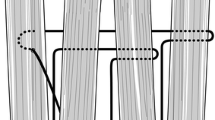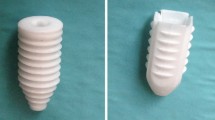Abstract
Introduction
The aim of this study was to compare the biomechanical properties of tibial fixation of a free tendon graft in ACL reconstruction using the Shim, a new wedge-shaped implant, in an outside-in technique to fixation by the Shim used in an inside-out technique and fixation by interference screw in a porcine model.
Materials and methods
Porcine tibia and flexor tendons were used. In Group 1, the Shim was applied outside-in. In Group 2, the Shim was inserted inside-out. In the Group 3, an 8-mm interference screw was used. Ten specimens were tested in each group. Load-to-failure, elongation, stiffness and failure mode were recorded. Cyclic loading was performed between 5 and 250 N for 1,000 cycles, followed by a load to failure testing.
Results
Mean maximum load-to-failure was 629.53 N in Group 1,648.54 N in Group 2 and 749.53 N in Group 3. There was no significant difference between the groups. Stiffness varied between 127.34 N/mm in Group 1, 151.27 N/mm in Group 2 and 182.25 N/mm in Group 3. No significant differences were found between outside-in Shim and interference screw fixation. No significant difference was found for elongation among the three groups. The main failure mode was a rupture of the tendon in the IFS group and a slippage of either the implant or the tendon in both groups using the Shim.
Conclusions
As no statistically significant difference could be seen concerning load to failure, stiffness and elongation between the inside-out and the outside-in techniques, the Shim can be used for tibial fixation in an outside-in or inside-out technique depending on the preference of the surgeon. To prevent slippage of the graft a hybrid fixation should be considered.





Similar content being viewed by others
References
Au AG, Otto DD, Raso VJ, Amirfazli A (2005) Investigation of a hybrid method of soft tissue graft fixation for anterior cruciate ligament reconstruction. Knee 12(2):149–153
Black KP, Saunders MM, Stube KC, Moulton MJ, Jacobs CR (2000) Effects of interference fit screw length on tibial tunnel fixation for anterior cruciate ligament reconstruction. Am J Sports Med 28(6):846–849
Bryan JM, Bach BR Jr, Bush-Joseph CA, Fisher IM, Hsu KY (1996) Comparison of “inside-out” and “outside-in” interference screw fixation for anterior cruciate ligament surgery in a bovine knee. Arthroscopy 12(1):76–81
Coleridge SD, Amis AA (2004) A comparison of five tibial-fixation systems in hamstring-graft anterior cruciate ligament reconstruction. Knee Surg Sports Traumatol Arthrosc 12(5):391–397
Fauno P, Kaalund S (2005) Tunnel widening after hamstring anterior cruciate ligament reconstruction is influenced by the type of graft fixation used: a prospective randomized study. Arthroscopy 21(11):1337–1341
Giurea M, Zorilla P, Amis AA, Aichroth P (1999) Comparative pull-out and cyclic-loading strength tests of anchorage of hamstring tendon grafts in anterior cruciate ligament reconstruction. Am J Sports Med 27(5):621–625
Griffin LY, Albohm MJ, Arendt EA et al (2006) Understanding and preventing noncontact anterior cruciate ligament injuries: a review of the Hunt Valley II meeting, January 2005. Am J Sports Med 34(9):1512–1532
Halewood C, Hirschmann MT, Newman S, Hleihil J, Chaimski G, Amis AA (2011) The fixation strength of a novel ACL soft-tissue graft fixation device compared with conventional interference screws: a biomechanical study in vitro. Knee Surg Sports Traumatol Arthrosc 19(4):559–567
Herbort M, Heletta S, Raschke MJ et al (2012) Accidental perforation of the lateral femoral cortex in ACL reconstruction: an investigation of mechanical properties of different fixation techniques. Arthroscopy 28(3):382–389
Herbort M, Weimann A, Zantop T, Strobel M, Raschke M, Petersen W (2007) Initial fixation strength of a new hybrid technique for femoral ACL graft fixation: the bone wedge technique. Arch Orthop Trauma Surg 127(9):769–775
Holden JP, Grood ES, Korvick DL, Cummings JF, Butler DL, Bylski-Austrow DI (1994) In vivo forces in the anterior cruciate ligament: direct measurements during walking and trotting in a quadruped. J Biomech 27(5):517–526
Hulstyn M, Fadale PD, Abate J, Walsh WR (1993) Biomechanical evaluation of interference screw fixation in a bovine patellar bone-tendon-bone autograft complex for anterior cruciate ligament reconstruction. Arthroscopy 9(4):417–424
Jomha NM, Raso VJ, Leung P (1993) Effect of varying angles on the pullout strength of interference screw fixation. Arthroscopy 9(5):580–583
Kurosaka M, Yoshiya S, Andrish JT (1987) A biomechanical comparison of different surgical techniques of graft fixation in anterior cruciate ligament reconstruction. Am J Sports Med 15(3):225–229
Lee YS, Han SH, Kim JH (2012) A biomechanical comparison of tibial back side fixation between suspensory and expansion mechanisms in trans-tibial posterior cruciate ligament reconstruction. Knee 19(1):55–59
Lenschow S, Herbort M, Strasser A et al (2011) Structural properties of a new device for graft fixation in cruciate ligament reconstruction: the shim technique. Arch Orthop Trauma Surg 131(8):1067–1072
Liu SH, Kabo JM, Osti L (1995) Biomechanics of two types of bone-tendon-bone graft for ACL reconstruction. J Bone Jt Surg Br 77(2):232–235
Ma CB, Francis K, Towers J, Irrgang J, Fu FH, Harner CH (2004) Hamstring anterior cruciate ligament reconstruction: a comparison of bioabsorbable interference screw and endobutton-post fixation. Arthroscopy 20(2):122–128
Matsumoto A, Yoshiya S, Muratsu H et al (2006) Mechanical evaluation of a soft tissue interference screw with a small diameter: significance of graft/bone tunnel cross-sectional area ratio. Knee Surg Sports Traumatol Arthrosc 14(4):330–334
Musgrove TP, Salmon LJ, Burt CF, Pinczewski LA (2000) The influence of reverse-thread screw femoral fixation on laxity measurements after anterior cruciate ligament reconstruction with hamstring tendon. Am J Sports Med 28(5):695–699
Nagarkatti DG, McKeon BP, Donahue BS, Fulkerson JP (2001) Mechanical evaluation of a soft tissue interference screw in free tendon anterior cruciate ligament graft fixation. Am J Sports Med 29(1):67–71
Nurmi JT, Jarvinen TL, Kannus P, Sievanen H, Toukosalo J, Jarvinen M (2002) Compaction versus extraction drilling for fixation of the hamstring tendon graft in anterior cruciate ligament reconstruction. Am J Sports Med 30(2):167–173
Odensten M, Gillquist J (1985) Functional anatomy of the anterior cruciate ligament and a rationale for reconstruction. J Bone Jt Surg Am 67(2):257–262
Offerhaus C, Balke M, Braas M, Pennig D, Gick S, Höher J (2013) Knee laxity in anterior cruciate ligament reconstruction: the influence of graft rotation using interference screw fixation. Unfallchirurg [Epub ahead of print]
Oh YH, Namkoong S, Strauss EJ et al (2006) Hybrid femoral fixation of soft-tissue grafts in anterior cruciate ligament reconstruction using the endobutton CL and bioabsorbable interference screws: a biomechanical study. Arthroscopy 22(11):1218–1224
Piltz S, Dieckmann R, Meyer L, Strunk P, Plitz W, Lob G (2005) Biomechanical evaluation of a bioabsorbable expansion bolt for hamstring graft fixation in ACL reconstruction: an experimental study in calf tibial bone. Arch Orthop Trauma Surg 125(9):577–584
Piltz S, Strunk P, Meyer L, Plitz W, Lob G (2004) Fixation strength of a novel bioabsorbable expansion bolt for patellar tendon bone graft fixation: an experimental study in calf tibial bone. Knee Surg Sports Traumatol Arthrosc 12(5):376–383
Scheffler SU, Sudkamp NP, Gockenjan A, Hoffmann RF, Weiler A (2002) Biomechanical comparison of hamstring and patellar tendon graft anterior cruciate ligament reconstruction techniques: the impact of fixation level and fixation method under cyclic loading. Arthroscopy 18(3):304–315
Tsuda E, Fukuda Y, Loh JC, Debski RE, Fu FH, Woo SL (2002) The effect of soft-tissue graft fixation in anterior cruciate ligament reconstruction on graft-tunnel motion under anterior tibial loading. Arthroscopy 18(9):960–967
Weiler A, Hoffmann RF, Bail HJ, Rehm O, Sudkamp NP (2002) Tendon healing in a bone tunnel. Part II: histologic analysis after biodegradable interference fit fixation in a model of anterior cruciate ligament reconstruction in sheep. Arthroscopy 18(2):124–135
Weiler A, Peine R, Pashmineh-Azar A, Abel C, Sudkamp NP, Hoffmann RF (2002) Tendon healing in a bone tunnel. Part I: biomechanical results after biodegradable interference fit fixation in a model of anterior cruciate ligament reconstruction in sheep. Arthroscopy 18(2):113–123
Weiler A, Windhagen HJ, Raschke MJ, Laumeyer A, Hoffmann RF (1998) Biodegradable interference screw fixation exhibits pull-out force and stiffness similar to titanium screws. Am J Sports Med 26(1):119–126
Weimann A, Zantop T, Herbort M, Strobel M, Petersen W (2006) Initial fixation strength of a hybrid technique for femoral ACL graft fixation. Knee Surg Sports Traumatol Arthrosc 14(11):1122–1129
Zantop T, Weimann A, Schmidtko R, Herbort M, Raschke MJ, Petersen W (2006) Graft laceration and pullout strength of soft-tissue anterior cruciate ligament reconstruction: in vitro study comparing titanium, poly-d, l-lactide, and poly-d, l-lactide-tricalcium phosphate screws. Arthroscopy 22(11):1204–1210
Author information
Authors and Affiliations
Corresponding author
Additional information
S. Lenschow and B. Schliemann contributed equally to this study.
Rights and permissions
About this article
Cite this article
Lenschow, S., Schliemann, B., Schulze, M. et al. Comparison of outside-in and inside-out technique for tibial fixation of a soft-tissue graft in ACL reconstruction using the Shim technique. Arch Orthop Trauma Surg 134, 1293–1299 (2014). https://doi.org/10.1007/s00402-014-2029-1
Received:
Published:
Issue Date:
DOI: https://doi.org/10.1007/s00402-014-2029-1




